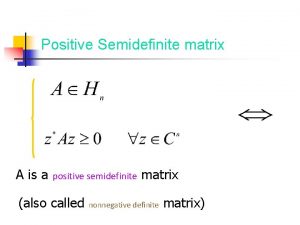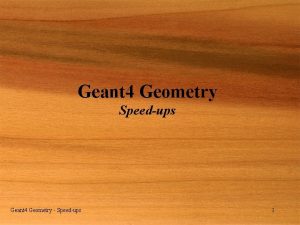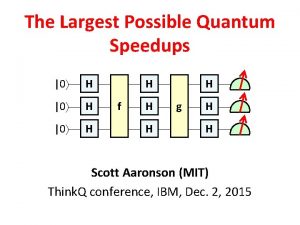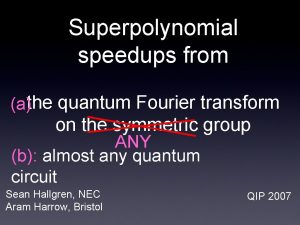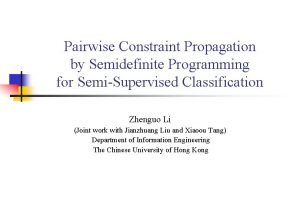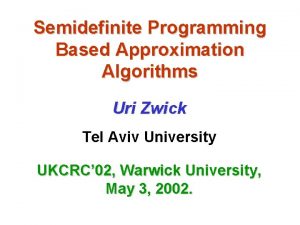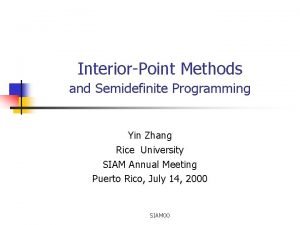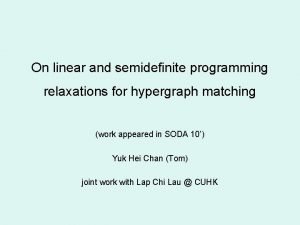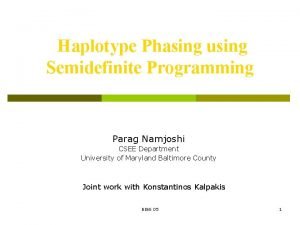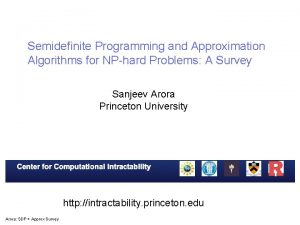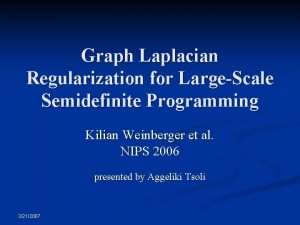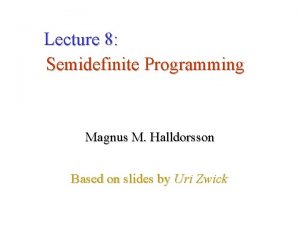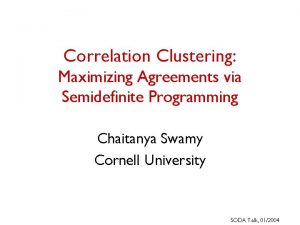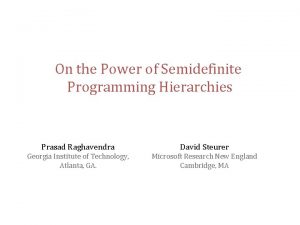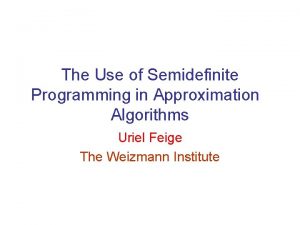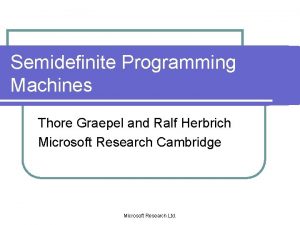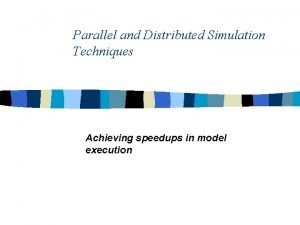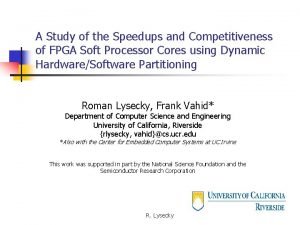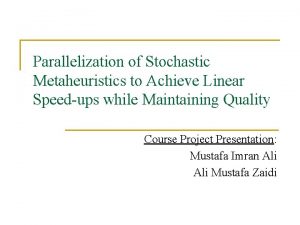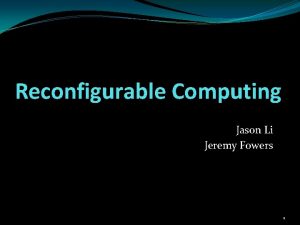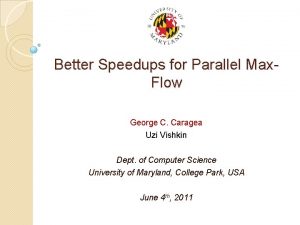Quantum Speedups for Semidefinite Programming Fernando G S





































- Slides: 37

Quantum Speed-ups for Semidefinite Programming Fernando G. S. L. Brandão MSR -> Caltech based on joint work with Krysta Svore MSR Faculty Summit 2016

Quantum Algorithms Exponential speed-ups: Simulate quantum physics, factor big numbers (Shor’s algorithm), …, Polynomial Speed-ups: Searching (Grover’s algorithm: N 1/2 vs O(N)), . . . Heuristics: Quantum annealing (adiabatic algorithm), machine learning, . . .

Quantum Algorithms Exponential speed-ups: Simulate quantum physics, factor big numbers (Shor’s algorithm), …, Polynomial Speed-ups: Searching (Grover’s algorithm: N 1/2 vs O(N)), . . . Heuristics: Quantum annealing (adiabatic algorithm), machine learning, . . . This Talk: Solving Semidefinite Programming belongs here

Semidefinite Programming … is an important class of convex optimization problems Input: n x n, r-sparse matrices C, A 1, . . . , Am and numbers b 1, . . . , bm Output: X Some Applications: operations research (location probems, scheduing, . . . ), bioengineering (flux balance analysis, . . . ), approximating NP-hard problems (max-cut, . . . ), field theory (conformal bootstraping), . . . Algorithms Interior points: Multilicative Weights: O((m 2 nr + mn 2)log(1/ε)) O((mnr/ε 2)) Lower bound: No faster than Ω(nm), for constant ε and r

Semidefinite Programming … is an important class of convex optimization problems Input: n x n, r-sparse matrices C, A 1, . . . , Am and numbers b 1, . . . , bm Output: X Some Applications: operations research (location probems, scheduling, . . . ), bioengineering (flux balance analysis, . . . ), approximating NP-hard problems (max-cut, . . . ), . . . Algorithms Interior points: Multilicative Weights: O((m 2 nr + mn 2)log(1/ε)) O((mnr/ε 2)) Lower bound: No faster than Ω(nm), for constant ε and r

Semidefinite Programming … is an important class of convex optimization problems Input: n x n, r-sparse matrices C, A 1, . . . , Am and numbers b 1, . . . , bm Output: X Some Applications: operations research (location probems, scheduling, . . . ), bioengineering (flux balance analysis, . . . ), approximating NP-hard problems (max-cut, . . . ), . . . Algorithms Interior points: O((m 2 nr + mn 2)log(1/ε)) Multiplicative Weights: O((mnr (�R)/ε 2)) Lower bound: No faster than Ω(nm), for constant ε and r

Semidefinite Programming … is an important class of convex optimization problems Input: n x n, r-sparse matrices C, A 1, . . . , Am and numbers b 1, . . . , bm Output: X Some Applications: operations research (location probems, scheduling, . . . ), bioengineering (flux balance analysis, . . . ), approximating NP-hard problems (max-cut, . . . ), . . . Algorithms Interior points: O((m 2 nr + mn 2)log(1/ε)) Multiplicative Weights: O((mnr (�R)/ε 2)) Lower bound: No faster than Ω(nm), for constant ε, r, �, R

Semidefinite Programming Normalization: We assume: Reduction optimization to decision: or

SDP Duality Primal: Dual:

Quantum Algorithm for SDP thm There is a quantum algorithm for solving SDPs running in time Õ(n 1/2 m 1/2 r δ-2 R 2)

Quantum Algorithm for SDP thm There is a quantum algorithm for solving SDPs running in time Õ(n 1/2 m 1/2 r δ-2 R 2) Input: n x n matrices r-sparse C, A 1, . . . , Am and numbers b 1, . . . , bm Output: Samples from y/||y||2 and ||y||2 Q. Samples from X/tr(X) and tr(X) Primal: Dual: or

Quantum Algorithm for SDP thm There is a quantum algorithm for solving SDPs running in time Õ(n 1/2 m 1/2 r δ-2 R 2) Input: n x n matrices r-sparse C, A 1, . . . , Am and numbers b 1, . . . , bm Output: Samples from y/||y||2 and ||y||2 Q. Samples from X/tr(X) and tr(X) Oracle Model: We assume there’s an oracle that outputs a chosen non-zero entry of C, A 1, . . . , Am at unit cost: choice of Aj row k l non-zero element

Quantum Algorithm for SDP thm There is a quantum algorithm for solving SDPs running in time Õ(n 1/2 m 1/2 r δ-2 R 2) Classical lower bound At least time Ω(max(n, m) for r, δ, R = Ω(1). Reduction from Search Quantum lower bound At least time Ω(max(n 1/2, m 1/2) for r, δ, R = Ω(1). Reduction from Search Ex. Ω(max(m)): bi = 1, C = I i) Aj = I for all j ii) Aj = 2 I for random j in [m] and Ak = I for k ≠ j (obj = 1) (obj = 1/2)

Quantum Algorithm for SDP thm There is a quantum algorithm for solving SDPs running in time Õ(n 1/2 m 1/2 r δ-2 R 2) thm 2 There is a quantum algorithm for solving SDPs running in time Õ(TGibbs m 1/2 r δ-2 R 2) If Gibbs states can be prepared quickly (e. g. by quantum metropolis), larger speed-ups possible

Quantum Algorithm for SDP The quantum algorithm is based on a classical algorithm for SDP due to Arora and Kale (2007) based on the multiplicative weight method Let’s review their method

The Oracle Searches for a vector y s. t. i) ii) Dual:

Width of SDP

Arora-Kale Algorithm 1. 2. 3. 4.

Why Arora-Kale works? Since Must check From Oracle, We need: is feasible

Matrix Multiplicative Weight MMW (Arora, Kale ‘ 07) Given n x n matrices Mt and ε < ½, with and λn : min eigenvalue 2 -player zero-sum game interpretation: - Player A chooses density matrix Xt - Player B chooses matrix 0 < Mt<I Pay-off: tr(Xt Mt) “Xt = �t strategy almost as good as global strategy”

Arora-Kale Algorithm 1. 2. 3. 4.

Arora-Kale Algorithm 1. 2. 3. 4. How to implement the Oracle?

Implementing Oracle by Gibbs Sampling Searches for a vector y s. t. i) ii)

Implementing Oracle by Gibbs Sampling Searches for (non-normalized) probability distribution y satisfying two linear constraints: claim: We can take Y to be Gibbs: There are constants N, x, y s. t.

Jaynes’ Principle (Jaynes 57) Let �be a quantum state s. t. Then there is a Gibbs state of the form with same expectation values. Drawback: no control over size of the λi’s.

Finitary Jaynes’ Principle (Lee, Raghavendra, Steurer ‘ 15) Let �s. t. Then there is a with s. t. (Note: Used to prove limitations of SDPs for approximating constraints satisfaction problems)

Implementing Oracle by Gibbs Sampling Claim There is a Y of the form with x, y < log(n)/ε and N < α s. t. N < α:

Implementing Oracle by Gibbs Sampling Claim There is a Y of the form with x, y < log(n)/ε and N < α s. t. Can implement oracle by exhaustive searching over x, y, N for a Gibbs distribution satisfying constraints above (only α log 2(n)/ε 3 different triples needed to be checked)

Arora-Kale Algorithm 1. Using Gibbs Sampling 2. 3. 4. Again, it’s Gibbs Sampling

Quantum Speed-ups for Gibbs Sampling (Poulin, Wocjan ’ 09, Chowdhury, Somma ‘ 16) Given a r-sparse D x D Hamiltonian H, one can prepare exp(H)/tr(…) to accuracy ε on a quantum computer with O(D 1/2 r ||H|| polylog(1/ ε)) calls to an oracle for the entries of H Based on amplitude amplification

Quantizing Arora-Kale 1. Use Gibbs Sampling 2. 3. 4. Again, Gibbs Sampling

Quantizing Arora-Kale Problem: Mt is not sparse. Solution: Sparsify it using operator Chernoff bound 1. Using Gibbs Sampling 2. 3. 4. Again, Gibbs Sampling

Sparsification Suppose Z 1, …, Zk are independent n x n Hermitian matrices s. t. E(Zi)=0, ||Zi||<λ. Then Applying to Sampling j 1, …, jk from with k = O(log(n)/ε 2)

Quantizing Arora-Kale 1. Use Gibbs sampling 2. Sparsify by random sampling 3. 4. Again, Gibbs sampling

Quantizing Arora-Kale 1. 2. Takes Õ(n 1/2 r) Use Gibbs sampling time on a quantum computer Sparsify by random sampling 3. 4. Again, Gibbs sampling

Quantizing Arora-Kale Use Gibbs sampling 1. 2. Needs to prepare: exp(∑i hi |i><i|)/tr(…) with hi = x Sparsify tr(Ai �t) + yby bi random sampling Can do quantumly with Õ(m 1/2) calls to an oracle to h. 3. Each call to h consists in estimating the value of tr(Ai �t). To estimate needs to prepare copies of �t, which costs Õ(n 1/2 r) 4. Overall: Õ(n 1/2 m 1/2 r)

Conclusion and Open Problems We showed quantum computers can speed-up the solution of SPDs One application is to solve the Goesman-Williamson SDP for Max-Cut in time Õ(|V|). Are there more applications? - Can we improve the parameters? - Can we find (interesting) instances where there are superpolynomial speed-ups? - Quantum speed-up for interior-point methods? Thanks!
 Sigular matrix
Sigular matrix Quantum physics vs mechanics
Quantum physics vs mechanics Classical physics
Classical physics Windows 10 system programming, part 1
Windows 10 system programming, part 1 Integer programming vs linear programming
Integer programming vs linear programming Perbedaan linear programming dan integer programming
Perbedaan linear programming dan integer programming Definisi integer
Definisi integer Greedy vs dynamic
Greedy vs dynamic Tobinskatten för och nackdelar
Tobinskatten för och nackdelar Hur ser ett referat ut
Hur ser ett referat ut Varför kallas perioden 1918-1939 för mellankrigstiden?
Varför kallas perioden 1918-1939 för mellankrigstiden? Programskede byggprocessen
Programskede byggprocessen Stig karttecken
Stig karttecken Mitos steg
Mitos steg Rbk fuktmätning
Rbk fuktmätning Kraft per area
Kraft per area Elektronik för barn
Elektronik för barn Förklara densitet för barn
Förklara densitet för barn Tack för att ni har lyssnat
Tack för att ni har lyssnat Smärtskolan kunskap för livet
Smärtskolan kunskap för livet Jiddisch
Jiddisch Typiska drag för en novell
Typiska drag för en novell Fimbrietratt
Fimbrietratt Trög för kemist
Trög för kemist Multiplikation uppställning
Multiplikation uppställning Magnetsjukhus
Magnetsjukhus Indikation för kejsarsnitt på moderns önskan
Indikation för kejsarsnitt på moderns önskan Toppslätskivling dos
Toppslätskivling dos Redogör för vad psykologi är
Redogör för vad psykologi är Borra hål för knoppar
Borra hål för knoppar En lathund för arbete med kontinuitetshantering
En lathund för arbete med kontinuitetshantering Mat för unga idrottare
Mat för unga idrottare Gumman cirkel
Gumman cirkel Bris för vuxna
Bris för vuxna Etik och ledarskap etisk kod för chefer
Etik och ledarskap etisk kod för chefer Svenskt ramverk för digital samverkan
Svenskt ramverk för digital samverkan Kvinnlig mantel i antikens rom
Kvinnlig mantel i antikens rom Datorkunskap för nybörjare
Datorkunskap för nybörjare
